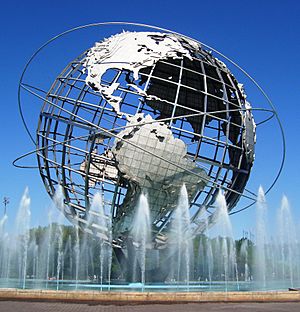Boroughs of New York City facts for kids
The boroughs of New York City are the five main parts that make up the big city of New York City. Think of them like five big neighborhoods or districts that together form one giant city! These five boroughs are the Bronx, Brooklyn, Manhattan, Queens, and Staten Island.
Each borough is also its own county in New York State. For example, The Bronx is also Bronx County, Brooklyn is Kings County, Manhattan is New York County, Queens is Queens County, and Staten Island is Richmond County.
All five boroughs were created in 1898. This is when modern New York City was formed by joining together New York County (which then included the Bronx), Kings County, Richmond County, and part of Queens County under one new city government. All the smaller towns and villages in these areas became part of the new, bigger city.
New York City first started on Manhattan Island. As the city grew, it added land from other areas. In 1874 and 1895, it took parts of Westchester County into New York County. When the city became bigger in 1898, this new land became the Borough of the Bronx. In 1914, Bronx County was made separate from New York County, so each borough then matched its own county.
When the western part of Queens County joined New York City in 1898, it became the Borough of Queens. In 1899, the eastern part of Queens County became Nassau County on Long Island. After that, the Borough of Queens and Queens County were the same size.
Contents
What is a Borough?
The word borough was chosen in 1898 to describe how the five main parts of the new, bigger city would be governed. Under the rules set by New York State, a borough is created when a county joins with the towns and cities inside it to form one larger city.
The boroughs in New York City have limited powers. The main power belongs to the government of New York City. This is different from how the word "borough" is used in places like New Jersey or Pennsylvania, where a borough is often a small, independent town.
Why Are There Five Boroughs?
|
New York City's five boroughs
|
||||||
|---|---|---|---|---|---|---|
| Jurisdiction | Population | Land area | Density | |||
| Borough | County | Estimate (2015) |
square miles |
square km |
persons / sq. mi |
persons / sq. km |
|
|
|
1,644,518 | 22.83 | 59.1 | 72,033 | 27,826 |
|
|
|
1,455,444 | 42 | 110 | 34,653 | 13,231 |
|
|
|
2,636,735 | 71 | 180 | 37,137 | 14,649 |
|
|
|
2,339,150 | 109 | 280 | 21,460 | 8,354 |
|
|
|
474,558 | 58.5 | 152 | 8,112 | 3,132 |
|
|
8,550,405 | 303.33 | 781.1 | 28,188 | 10,947 | |
|
|
19,795,791 | 47,214 | 122,284 | 416.4 | 159 | |
|
|
||||||
People often talk about New York City as the five boroughs. This helps everyone know they are talking about the whole city, not just one part like Manhattan. It also helps politicians show that all five boroughs are equally important. The term outer boroughs refers to all the boroughs except Manhattan.
How the Boroughs Changed Over Time
All five boroughs were created in 1898 when the city's modern borders were set.
The Bronx originally included parts of New York County that used to be in Westchester County. These areas were added in two steps: in 1874 and 1894. Finally, in 1914, Bronx County became the newest county created in New York State.
The borough of Queens used to be only the western part of a larger Queens County. In 1899, the three eastern towns of Queens County that did not join New York City became the new Nassau County.
The borough of Staten Island, which is the same as Richmond County, was officially called the borough of Richmond until 1975. Its name was changed to Staten Island to match what most people called it, but the county name stayed Richmond.
Exploring the Five Boroughs
There are hundreds of different neighborhoods across the five boroughs of New York City. Many of them have their own unique history and feel.
Manhattan: The City's Heart
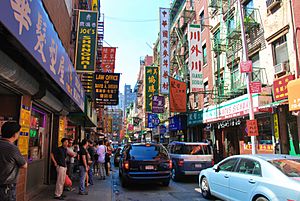
- Manhattan (also New York County) is the smallest borough in size but has the most people living in it. It is the symbol of New York City, with most of the city's tall skyscrapers and famous places like Times Square and Central Park. People sometimes just call it The City. Manhattan is the cultural, business, and financial center of New York City. It has the United Nations Headquarters, Wall Street, and many important universities. Many people think of Manhattan as the world's capital for culture, finance, media, and entertainment.
Most of Manhattan is on Manhattan Island, where the Hudson River meets the sea. Some smaller islands are also part of Manhattan, like Randall's Island, Wards Island, and Roosevelt Island in the East River. Governors Island and Liberty Island (where the Statue of Liberty stands) are also part of Manhattan. Manhattan Island is generally split into Lower, Midtown, and Uptown areas. The other four boroughs of New York City are often called the outer boroughs.
Brooklyn: A Diverse Hub
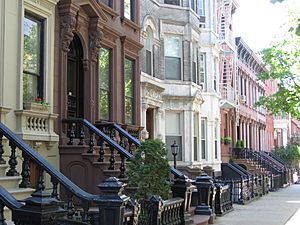
- Brooklyn (also Kings County) is on the western tip of Long Island and is the borough with the most people. Brooklyn is known for its many different cultures, people, and art. It has many distinct neighborhoods and unique buildings. Downtown Brooklyn is the biggest central area in the outer boroughs. The borough has a long beach area, including Coney Island, which became one of the first amusement parks in the country in the 1870s. Marine Park and Prospect Park are Brooklyn's two largest parks. Since the early 2010s, Brooklyn has become a busy place for new businesses and high tech companies, as well as modern art and design.
Queens: The World's Most Diverse Place
- Queens (also Queens County) is on Long Island, north and east of Brooklyn. It is the largest borough by land size and the most ethnically diverse county in the United States. It is also the most diverse urban area in the world! Queens was once a group of small towns started by the Dutch. Now, it has grown into a major area for both businesses and homes. Downtown Flushing is one of the busiest central neighborhoods in the outer boroughs. Some parts of Queens, like Bellerose and Forest Hills, feel more like suburbs. Queens is home to Citi Field, where the New York Mets baseball team plays. It also hosts the yearly U.S. Open tennis tournament at Flushing Meadows-Corona Park. Plus, two of the three busiest airports serving New York City, John F. Kennedy International Airport and LaGuardia Airport, are in Queens.
The Bronx: Mainland and Green Spaces
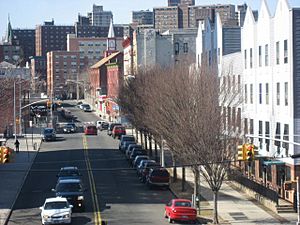
- The Bronx (also Bronx County) is New York City's northernmost borough. It is the only New York City borough that is mostly on the United States mainland. It is where Yankee Stadium is located, home to the New York Yankees baseball team. The Bronx is also home to Co-op City, the largest cooperatively owned housing complex in the United States. You can also find the Bronx Zoo here, which is the world's largest city zoo, covering about 265 acres and housing over 6,000 animals. Right next to the zoo is the New York Botanical Garden, a beautiful garden and a National Historic Landmark. Pelham Bay Park is the largest park in New York City, covering about 2,772 acres.
Staten Island: The Suburban Borough
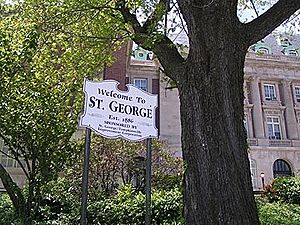
- Staten Island (also Richmond County) feels the most like a suburb compared to the other four boroughs. Staten Island is connected to Brooklyn by the Verrazzano-Narrows Bridge. You can travel to Manhattan by taking the Staten Island Ferry. This ferry is free for commuters and is a popular tourist attraction because it offers amazing views of the Statue of Liberty, Ellis Island, and Lower Manhattan. In the middle of Staten Island, the Staten Island Greenbelt covers about 2,500 acres. It has about 28 miles of walking trails and one of the last natural forests in the city. The Greenbelt was created in 1984 to protect the island's natural lands and includes seven city parks.
How the Boroughs Are Governed
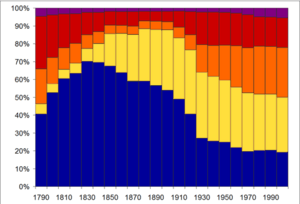
Since 1914, each of New York City's five boroughs has been the same as a county in New York State. This is different from most U.S. cities, which are usually in just one county or split between a few.
Each borough has a borough president. The borough presidents act as spokespeople and leaders for their boroughs. They have small budgets to help community groups and projects. They also choose members for the 59 community boards in the city's neighborhoods. The borough presidents of Brooklyn and Queens also help choose leaders for their local public libraries.
Because each borough is also a county, it elects a district attorney. A district attorney is a lawyer who works for the state government and handles criminal cases in that county. For example, the District Attorney of Manhattan is officially the District Attorney of New York County.
The "Sixth Borough"
The term "sixth borough" is used to describe places that are like a part of New York City, even if they are not officially one of the five boroughs. This can be because they are very close, have many former New Yorkers living there, or share a similar city feel.
For example, in 2011, New York Mayor Michael Bloomberg called the city's waterfront and waterways a "sixth borough." This was during talks about plans to improve the city's shoreline, including Governor's Island.
The Hudson Waterfront in New Jersey, which is across the Hudson River from Manhattan, is sometimes called the sixth borough. Cities like Jersey City and Hoboken in New Jersey are connected to New York City by the PATH trains. Fort Lee, New Jersey, which is across from Upper Manhattan and connected by the George Washington Bridge, has also been called the sixth borough. Yonkers, New York is another city often referred to as the sixth borough.
See also
 In Spanish: Borough (Nueva York) para niños
In Spanish: Borough (Nueva York) para niños


